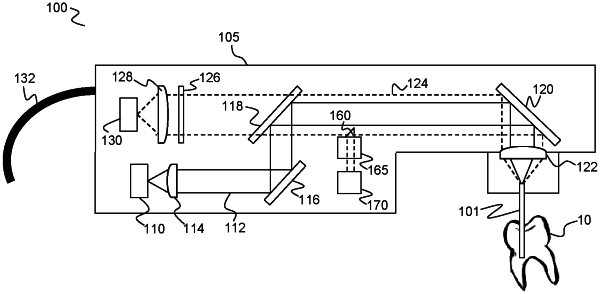| CPC A61B 5/0088 (2013.01) [A61B 5/0035 (2013.01); A61B 5/0093 (2013.01); A61B 5/4547 (2013.01); A61C 19/04 (2013.01); A61C 19/042 (2013.01); A61B 2560/0425 (2013.01); A61B 2562/0238 (2013.01); A61B 2576/02 (2013.01); A61C 5/40 (2017.02)] | 20 Claims |

|
1. A method of optically interrogating an interior region of a tooth using an intraoral probe, the intraoral probe comprising:
a body suitable for use in a handheld configuration;
a modulated light source housed within the body, wherein the modulated light source is configured to generate incident modulated optical energy;
an elongate optical waveguide extending from a distal region of the body, wherein the elongate optical waveguide is in optical communication with the modulated light source;
a first optical detector configured to detect luminescence energy; and
a second optical detector configured to detect photothermal energy;
the method comprising:
after inserting the elongate optical waveguide into the interior region of the tooth, employing the intraoral probe to deliver the incident modulated optical energy onto dental tissue within the interior region of the tooth and performing luminescence and photothermal measurements at a plurality of locations by:
collecting the luminescence energy responsively emitted from the dental tissue and detecting luminescence signals with the first optical detector;
collecting the photothermal energy responsively emitted from the dental tissue and detecting photothermal signals with the second optical detector; and
processing the luminescence signals and the photothermal signals to determine one or more measures; and
comparing the one or more measures to reference values to identify a presence of one or more of debris, cracks, a pulp chamber residing beneath the dental tissue, and an unexposed root canal on the floor of the pulp chamber.
|